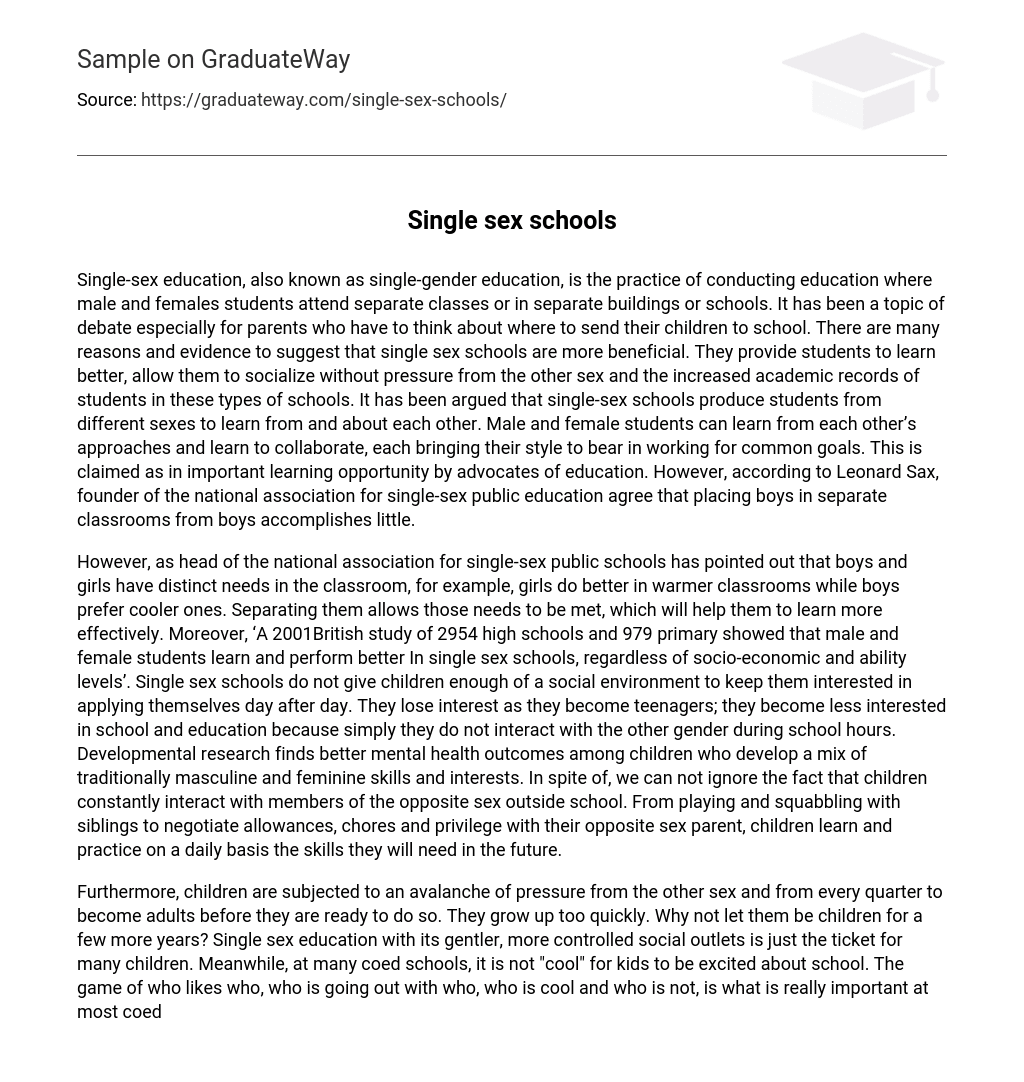Single-sex education, or single-gender education, involves educating male and female students in separate classes, buildings, or schools. This issue has sparked a debate among parents deciding where to send their children for schooling. There are multiple reasons and evidence suggesting that single-sex schools offer numerous advantages. These schools provide an improved learning environment for students, allowing them to socialize without the pressures of the opposite sex and resulting in better academic performance. Supporters argue that single-sex schools create opportunities for students of different genders to learn from and about each other by collaborating and utilizing their distinct styles to achieve common goals, thus enhancing their educational experiences. However, Leonard Sax, founder of the national association for single-sex public education, believes that separating boys from boys in separate classrooms has little value.
The head of the national association for single-sex public schools states that boys and girls have different classroom needs. Girls prefer warmer classrooms while boys prefer cooler ones. By separating them, their specific needs can be met, leading to more effective learning. According to a 2001 British study, both male and female students excel academically in single-sex schools regardless of socio-economic status or ability levels.
However, concerns exist about limited social interaction in single-sex schools. It is believed that this could lead to a lack of interest and engagement during adolescence as children may not develop enough interaction with the opposite gender during school hours. Nevertheless, research suggests that having a mix of traditionally masculine and feminine skills and interests leads to better mental health outcomes.
Despite these concerns, it should be noted that children regularly interact with members of the opposite sex outside of school through activities such as playing with siblings or negotiating with their opposite sex parent. These daily interactions allow children to practice skills they will need in the future.
Moreover, children face substantial pressure from both genders and various sources to mature prematurely, robbing them of their childhood. Allowing them to remain children for a few more years seems like a reasonable option. For many children, single sex education offers a solution through its more controlled and gentle social interactions. In contrast, at coeducational schools, being enthusiastic about academics is not deemed “cool” by their peers. Instead, the focus is on romantic relationships, popularity, and social status. This scenario is less common in single-sex schools. While critics argue that there is insufficient research demonstrating any enhancement in academic performance from single-sex education, credible educational studies have proven the contrary. Single-sex education has not shown superior achievement outcomes as commonly believed. Nevertheless, it elevates public school students to new academic heights by providing a broader range of educational opportunities. Most importantly, research indicates that single-sex education significantly elevates students’ reading scores, overall grades, and college acceptance rates.
John Fairhurst, principal of the Fairhurst High School in Essex, England, made the decision to transform his school into two single-sex academies within a shared facility. The curriculum and instructors remained the same for both boys and girls, but they attended separate classes. After three years, the percentage of Shenfield boys who achieved high scores on standardized tests increased by 26%. The girls also showed improvement, with a slightly lower increase of 22%, but they still outperformed the boys. Notably, educational researcher Cornelius Riordan, a Professor of Society at Providence College and author of the book Girls and Boys in School: Together or Separate?, concludes that females tend to excel academically in single-sex schools and colleges, regardless of cultural differences.
Overall, single-sex schools offer students a better learning environment, allowing them to socialize without pressure and achieving higher academic records. Additionally, single-sex education has the added advantage of broadening students’ horizons and allowing them to freely explore their strengths and interests.
The National Association for Same Sex Education, Posted at http://www.singlesexschools.org Rowe, Ken. “Boys and Girls Perform Better in Same Sex Schools.” Keynote address at the National Conference of Co-Education, posted at http://www.acer.edu.au/new s/MR_pages/MR_singlesexschools%2020.04.00.html A. Stables. Differences between pupils from mixed and single-sex schools in their enjoyment of school subjects and in their attitudes to science and to school. Educational Review, 42(3):221-230, 1990.Judith O’Reilly, “Mixed school hits new heights with single-sex classes.” Sunday Times (London), August 20, 2000.





